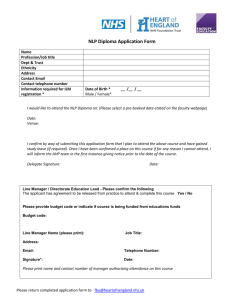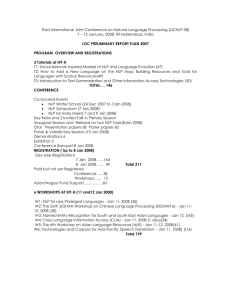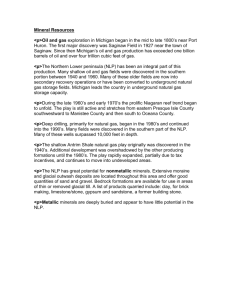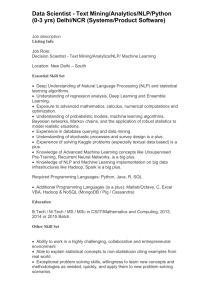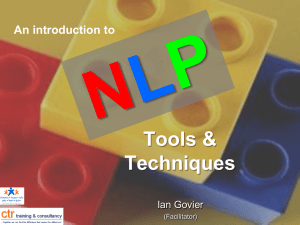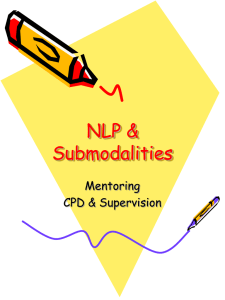NLP & Time Line Therapy Practitioner Evaluation
advertisement
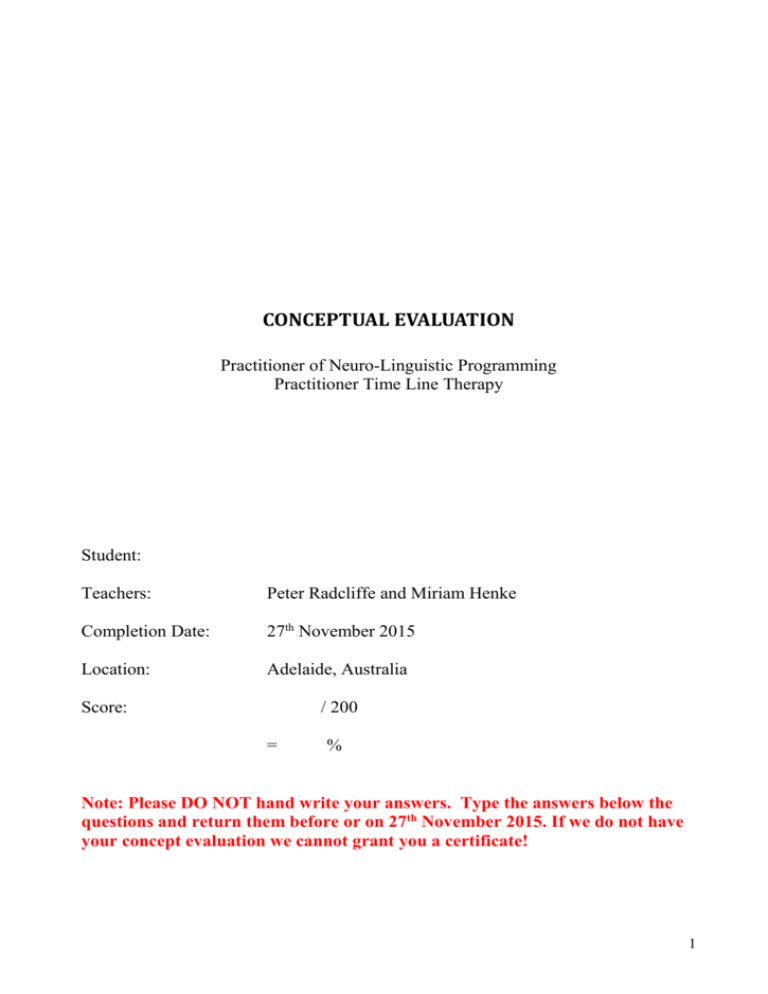
CONCEPTUAL EVALUATION Practitioner of Neuro-Linguistic Programming Practitioner Time Line Therapy Student: Teachers: Peter Radcliffe and Miriam Henke Completion Date: 27th November 2015 Location: Adelaide, Australia Score: / 200 = % Note: Please DO NOT hand write your answers. Type the answers below the questions and return them before or on 27th November 2015. If we do not have your concept evaluation we cannot grant you a certificate! 1 NLP Foundations and Presuppositions 1. What is the function of the presuppositions of NLP and should they be taken as true? [2] 2. What distinctions can you make between process and content? [2] 3. What is meant by the terms unconscious and conscious mind? [1] 4. List and discuss your 5 favourite NLP Presuppositions. [5] 5. What does George A Miller’s magic number “7+ or -2” refer to? [1] 6. What are the necessary and sufficient conditions for an outcome to be defined as “well formed”? [2] 7. Define and describe NLP in your own terms. You may quote from reputable sources if you wish. [2] 8. What is meant by a physiology and psychology of excellence? Why is it important? [2] 9. What is personal power and how does one get it? [2] Rapport 10. How does rapport differ from liking someone or agreeing with them? [2] 11. List 5 things to match or mirror to get into rapport with someone. [2] 12. In establishing and maintaining rapport with someone, how do you know when to pace and when and how much to lead them? [2] 13. What are the four indicators of rapport? [1] 14. What is cross-over mirroring? When is it useful? [2] Perceptual Positions and Managing State 15. What is meant by a state? [1] 16. Is there such a thing as an unresourceful (or stuck) state? [1] 17. What is the difference between a state and an outcome? [2] 18. What do the terms “associate” and “disassociate” mean? [1] 19. What is meant by perceptual position? [1] 2 20. Is there a relationship between association and disassociation and the perceptual positions first (self, own), third (director, observer) and second (other)? [2] 21. What is the value of using perceptual positions in the order first to third to second to third to first? [2] 22. What is a triple description and how is it useful? [2] Representational Systems 23. What is the difference between the primary, lead and reference representational systems? [3] 24. How does a person’s posture, rate and site of breathing, pitch and speed of speech indicate the likelihood that they are processing mostly in a particular representational system at that moment? Consider each of the 3 main representational systems in your answer. [3] 25. When addressing a group of people and using sensory-based predicates, which representational systems do we use and in what order? AKA The Charisma Pattern [1] 26. Draw and label an eye pattern chart for a normally organised right-handed person. [2] 27. Translate each of the following sentences into a different representational system: [3] Things look good. It is so quiet that you can hear a pin drop. You are really fired up! That sounds like a great idea. People don't see me as I see myself. Your words leave a sour taste in my mouth. Everyday above ground is a great day! Sensory Acuity and Calibration 28. What is a sensory-based description and how do you know you are reading or hearing one? [2] 29. What is calibration and how do you do it? [2] 30. List 4 means of calibrating minute physiological shifts with sensory acuity. [2] 31. What is mind reading (interpretation) and how can you catch yourself doing it? [2] 32. Which of the following descriptions are sensory based (S) and which are hallucinations or mind reads (MR)? [2] a) b) c) d) e) She was unperturbed. She smiled dreamily. His pupils dilated. She looked thrilled The volume of his voice was diminished 3 33. What is meant by taking an inventory of your state? [2] 34. List three possible combinations of attention splitting. [3] 35. What is the difference between simultaneous and sequential incongruity? [1] 36. How can you assist someone to become congruent? [2] Anchoring and Future Pacing 37. What is anchoring? [1] 38. What are the essential elements of anchoring? [1] 39. Describe the steps to collapsing a negative anchor, and tell when this would be useful. [3] 40. Describe the steps involved in creating a Neurological Bridge (Chaining Anchors process), and tell when this would be useful. [3] 41. How could you create a resource anchor for yourself? Describe the process and tell when it could be useful. [3] 42. How do you future pace a process and what would be your intent for doing so? [2] 43. Is it possible not to set and fire anchors when in the company of other people? [2] Meta Model 44. How do you know when to use the Meta Model? [1] 45. How do you know when not to use the Meta Model? [1] 46. What are the three type of language violations that the Meta Model is designed to reverse? [1] 47. What can you do to preserve your relationship with another person while meta-modelling their language patterns? [2] 48. Respond to each of the following Meta Model violations: [3] a) b) c) d) e) f) He hurt me You make me sad Our relationship is terrible He came home late, he doesn’t love me I shou1dn’t leave him I am supposed to do my job - Frames 4 49. What is a frame and how is it a useful concept? [2] 50. What is the agreement frame and when would it be useful? [2] 51. Describe the following frames and tell when to use them: [6] Evidence: Backtrack: Relevancy: Contrast: Ecology: As if: Reframing 52. What are the elements of a 6-step reframe? In what way is it a reframe? [3] 53. What is a reframe and when is it useful? [2] 54. What is the difference between a meaning reframe and a context reframe? [4] Give 3 examples of each. Sub modalities 55. What is the difference between an analogue and digital sub modality? [1] 56. What are sub-modalities? [1] 57. What are the three keys to really producing results with sub-modalities? [1] 58. What is contrastive analysis? [1] 59. What are driver sub modalities? [1] 60. What is a simple phobia? [1] 61. What is the intervention for a phobia? What are the key features of the process? [3] 62. What is a pattern interrupt and when is it useful? [2] 63. What makes it un-ecological to treat a complex phobia as if it were a simple phobia? [2] 64. Describe the process and lay out the steps for changing a belief with sub-modalities. [3] 65. List 5 visual predicates, 5 kinaesthetic predicates, 5 auditory predicates, and 5 auditory digital predicates. [5] 66. List 3 visual predicate phrases, List 3 kinaesthetic predicate phrases, 3 auditory predicate phases, and 3 auditory digital predicate phrases. [3] 5 67. List 6 visual, 6 kinaesthetic, and 6 auditory sub-modalities. [6] Milton Model 68. What is the Milton Model? [1] 69. Define the term embedded command. How do you do it? [2] 70. What is analogue marking? [1] 71. What is the difference between deep and shallow metaphor? [2] 72. How do you construct a metaphor? [3] 73. Name two contexts where you would use metaphor? [2] 74. When would you use the Meta Model in preference to the Milton Model and vice versa? [2] 75. Give an Example for each of the following Patterns of the Milton Model: [7] a) b) c) d) e) f) g) h) i) j) k) l) m) n) Mind Read: Cause and Effect Complex Equivalence Lost Performative Unspecified Verb Extended Quote Implied Causative Selectional Restriction Violation Phonological Ambiguity Syntactic Ambiguity Scope Ambiguity Double-Bind Analogical Marking Embedded Command Tag Question. Strategies 76. What is a strategy? [2] 77. How do you elicit a strategy? [2] 78. What is synaesthesia? [1] 79. What are the necessary and sufficient conditions for a strategy to be defined as well-formed? [2] 80. Describe the function and use of the T.O.T.E. model. [2] 81. What are the major components of a buying strategy? [1] 6 82. What are the major components of a love strategy? [1] Time Line Therapy® 83. How do you elicit a timeline? [1] 84. Draw your own time line arrangement. [1] 85. What is the difference between the experience of being in time and through time? [1] 86. What does ‘Gestalt’ in Time Line Therapy™ mean? [1] 87. What is the specific intervention for a negative emotion? [1] 88. What are the three things to check in position #3 if an emotion is not releasing? [3] 89. What is a limiting decision? How would you discover a client’s limiting decisions? [2] Additional Distinctions 90. Ecology is an essential consideration in all applications of NLP. What makes it so important and when would you use ecology checks? [2] 91. On which presupposition of NLP is modelling based? [1] 92. What is chunking? [1] 93. What are the most important Prime Directives of the Unconscious Mind? [1] 94. Describe a personal evolution process that you can do in five minutes for yourself every day. [1] 95. Describe Robert Dilt’s Logical Levels. [1] 96. List the steps for a Parts Integration, and when this would be useful. [3] 97. What is secondary gain? [1] 98. What are five NLP insights into conducting successful meetings? [5] 99. Why is ‘intent’ important in negotiations? [1] 100. Describe the 5-Step Sales Process. [2] What are your 3-month goals as you leave this training? 7



